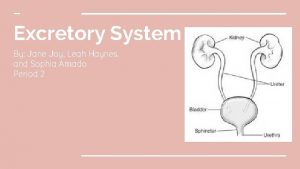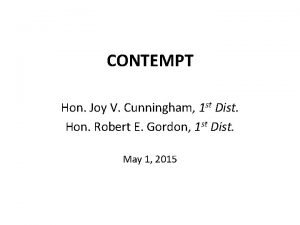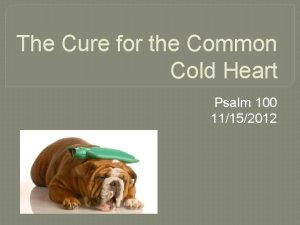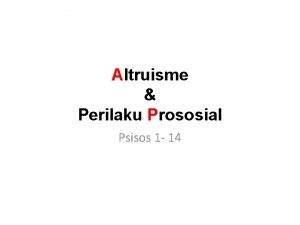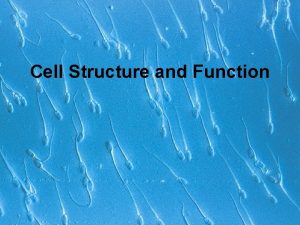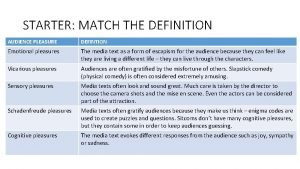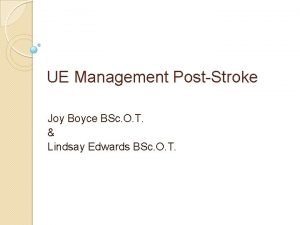David Joy z Dr David C Joy z


























































- Slides: 58

David Joy z. Dr. David C. Joy z. Distinguished Professor z. Materials Science and Engineering University of Tennessee Knoxville, TN z. D. Phil. , University of Oxford (UK): z A Study of Magnetic Domains in the SEM z. Hitachi payroll

A Clean Machine § The FEGSEM cannot operate except in a clean, ultrahigh vacuum. (Numerous caveats for low vacuum and ESEM operation. ) This requires items such as: § Scroll Pumps § Turbo Molecular Pumps § Ion Pumps § as well as associated gauges § and even with the cleanest of vacuums there is still The Dark Side of SEM that must be faced….

Terminology z“Low vacuum” = High pressure z“High Vacuum” = Low pressure

Common Vacuum Units § § § There are many varied units that are used to specify pressures The Torr, the Bar and the Pascal are in common use. . . but the Pascal is the SI recommended unit for pressure and so is the best choice for documentation l l l 1 Atmospheric pressure is 760 mm Hg = 1 Bar = 105 Pa 1 Torr = 1 mm Hg 1 Torr = 1/760 of an atmosphere = 132 Pa 1 milli. Torr = 0. 13 Pa = 1 μm. Hg 1 mbar = 1/1000 Atm = 0. 76 Torr = 100 Pa 1 Pa = 7. 6 milli. Torr = 7. 6 μm. Hg

Pressure: Units of Measure z. Pressure exerted by a column of fluid: z. P ≡ F/A = mg/A = gh. A/A = gh h z 1 Atm (mean sea level) = 760 Torr = 1013 m. Bar = 1. 01 x 105 Pa = 101. 3 k. Pa = 14. 7 psi = 34 ft. water z. Average atmospheric pressure in SLC is about 635 Torr, 12. 3 psi, 28. 4 ft water…

“Kinds of Pressure” z Gauge Pressure: measured with respect to ambient. z Absolute pressure: measured with respect to vacuum z Car tires, basketballs, boilers, LN 2 tanks, JFB/MEB compressed air supply… z Vacuum systems, cathode ray tubes, light bulbs, barometers

Mean Free Path in Gases With sufficient accuracy for approximate calculations we may take: λ = 7 x 10 -3/p mbar-cm λ = 5 x 10 -3/p Torr-cm λ = 5/p μm. Hg-cm

Qualitative Vacuum Ranges Low vacuum (SEC) 760 to 1 Torr laminar Medium vacuum (SEC) 1 to 10 -3 Torr High vacuum (Chamber) 10 -3 to 10 -6 Torr Very high Torr (Column) Ultra-high (Gun) 10 -6 to 10 -9 molecular 10 -9 and lower FEGSEMs contain examples of each vacuum level

Vacuum pumps z For each of the vacuum ranges identified earlier there is one or more type of pump that is best z Pumps are always used in combination - one pump is used to start the next z The sequencing of the pump down is crucial and so this is done under computer control

Scroll Pumps z Scroll pumps are the foundation of clean vacuum systems z They consist of two Archimedes’ screws machined into aluminum plates mounted so that the spirals interleave z One plate is held fixed while the other oscillates. Gas is trapped between the spirals and forced out to the exit port z Pumping speed is constant from Atmospheric pressure down to about 1000 Pa and the ultimate pressure is about 10 Pa z Scroll pumps are oil-free and require neither inlet nor outlet valves The world’s oldest pump technology – Archimedes’ screw

Alternatively…. z Roughing can also be carried out using a diaphragm pump z Oscillation of the diaphragm alternately pulls gas in one port and then expels it through the other. z Oil free pumps are clean but typically a factor of 3 x slower, and 3 x more expensive, than pumps containing oil – but worth the wait and expense

Rotary Vane Mechanical Pump z Robust z Inexpensive z Operates to ambient pressure z Single stage and two stage


Turbomolecular pump z Archimedian screw runs at 20000+ rpm z Needs electronic protection / control for the bearings in case of loss of power z Produces a clean, oilfree, high vacuum down to 10 -6 Pa (10 -8 Torr) z Must be backed: scroll pump, diaphragm pump or rotary oil pump.

Turbo pump performance z Turbo pumps can start even at atmospheric pressure (although they labor) and they can go down to 10 -8 T z It is best to pre-pump the system with a clean backing system z TMP do not pump all gases with same efficiency - large molecules are pumped faster than smaller molecules l 1 milli. T = 0. 13 Pa = 1 μm. Hg Turbo pump performance

Ion Pumps z Ionized molecules spiral in magnetic field and get buried in Ti wall coating z A large number of these structures are run in parallel to improve the pumping speed z Diode pumps only handle gases that are easily ionized (no noble gases)

The triode pump z If noble or unusual gases are expected to be found in the SEM (nitrogen, helium, counter gases from a WDS system etc. ) then a triode pump must be used. z The additional electrode then makes it possible to ionize these gases

Ion pump performance Ion Pump Performance z “The” UHV pump - goes to 10 -9 Pa (1011 Torr) and below in a properly designed vacuum system z Requires no backing…more than a little misleading… in fact it works best in a sealed system. Entrainment pump! z The IP requires a periodic bake-out into rough pumped system to clean the buried gas from the pump. This is done during the gun bake procedure z Check for electrical instability by slapping the pump with an open hand. Instability indicates need for a bake

Cryogenic pump z Cryo-pumps use liquid helium and activated charcoal absorbers to pump to 10 -12 T z Very high pumping speeds z No vibration or magnetic fields z But they need periodic bakeouts into a rough pump to clean the absorbers z They are expensive to run unless used with a closedcircuit (Stirling engine) liquid He pump

Vacuum Gauges z Vacuum systems must be monitored constantly to ensure satisfactory performance, but manufacturers seem to be reluctant to provide gauges which allow this to be done z Many different types of gauges are available because each only covers a limited range of pressures z Never trust a gauge unless you can check it independently Range of gauge utility

Pirani gauge Schematic Circuit for a Pirani (hot wire) gauge z The Pirani is a dedicated low vacuum gauge device z The resistance of the hot wire changes with the rate of heat loss (conduction) to the gas z The Wheatstone bridge then measures the change in resistance of the hot wire z Pirani’s are rugged and generally reliable and rarely need attention

Pirani calibration z The calibration of a Pirani depends on thermal conductivity and so on the actual gas in the system z Beware when using a crystal spectrometer as gases leaking from the counter tubes will degrade the accuracy of the Pirani gauge Correction Curve for Pirani Gauges

Penning (Cold cathode) Gauge Penning gauges require routine cleaning and testing z A Penning gauge measures the ion current flowing from the cathode to the anode z The magnetic field increases sensitivity by making the ions spiral as they travel to cause secondary ionization z Beware - a Penning gauge reads zero current when the pressure is both very low and very high. The gauge must ‘strike’ to be operational z Check with a Pirani gauge if in doubt

Capacitance Manometer Gauge head on chamber Controller and digital read-out

Capacitance Manometer z A = Annular electrode z D = Disk electrode z S = Substrate z G = Getter (in vacuum space) z Differential capacitance between annulus and disk depends on pressure difference between Test Chamber and “Getter”. (Earlier reference to “unbacked getter pump”)

Ion gauges z. Pressures lower than 10 -5 Torr can be measured with ion gauges (which are miniature ion pumps) or (more usually) directly from the actual ion pump z. Mass spectrometer gauges (residual gas analyzers) are a desirable extra. These can measure partial pressures of e. g helium (for leak testing) or of water vapor.

O-ring seals z O-rings (from the 1950 s) made it possible to build demountable vacuum systems z The rings are now made of high tech polymers such as VITON z Two kinds are in common use. . . 4 Black/shiny - has filler. Low vacuum only. Lubricate with finger grease to prevent cracking 4 Brown/dull - high vacuum, and bakeable. Do not grease z Do not crush or cut the ring ensure that it is in the groove designed for it

UHV metal to metal seals z First used in the 1960 s z Knife edges on the flanges cut into OFHC (oxygen free high conductivity) copper rings about 5 mm thick to make an impermeable metal to metal seal z Good down to pressures as low as 10 -10 Pa z Bakeable, clean, long lasting and (with care) reusable z Expensive - an 8 inch gasket costs ~ $100 z Don’t touch !

Vacuum Hygiene z Always keep vacuum systems running 24/7/365 z Use LN 2 cooled maze traps, and fore-line traps, to reduce backstreaming in older machines z Do not overpump the specimen exchange chamber (SEC) as this can result in backstreaming (unique to Hitachi FEG systems) z Keep your fingers away from samples and from the specimen chamber area - wear gloves z If column contamination occurs try nitrogen purging (laminar flow) over a weekend Maze trap fitted to a rotary pump (mfp discussion)

Cleaning samples CO 2 “snow gun” for sample cleaning z Do not use organic solvents as these are always contaminated, even the fresh ‘electronic grade’ material in brown glass bottles z Never, never, use squeeze or spray bottles as the TEFLON filler goes into solution 4 Use detergents instead e. g. Alconox ‘Detergent 8’ which are bio-degradeable and leaves no residue 4 Carbon Dioxide ‘snow’ cleaning no residue and good solvent action but expensive to set up. www. co 2 clean. com

Clean is not for ever. . . z As soon as a specimen is prepared for observation it begins to get dirty again (CCW rule: “one monolayer/sec at 10 -6 Torr) z Even storing the sample in a vacuum dessicator will not prevent the growth of bacterial or microbial surface contaminant films because the source of the problem is carried in by the specimen itself z Remedial action is required As prepared After one week

Plasma cleaning Same sample after plasma cleaning z Plasma cleaning is a rapid and easy way of removing the build-up of surface contaminants z Fast and non-destructive

The Dark Side of SEM z. The interaction of electrons with solids results in a variety of interactions which give us uniquely valuable information about the sample z. But these same interactions can also result in either temporary or permanent damage to the sample z. Know your enemy!

Unwanted Beam Interactions Radiation Damage Ionization Displacement Heating Intrinsic to electron beam irradiation Contamination Etching Results from vacuum problems Both are usually important

Unwanted beam interactions z Electron beams have bad effects on organic, polymeric, and ionic materials z This is ‘radiolysis’ Effect of 0. 01 m. C/cm on protein protoxin Shrinkage of Ar. F resist 1 m. C/cm 2 500 nm

Radiolysis is…. z Radiolysis is the breaking of bonds as the result of ionization by the electron. z Electrons are the most intense source of ionizing radiation available - the typical dose in an SEM is equivalent to standing 6 foot from a 10 megaton H -bomb Compare SEM to Sun and SPEAR

Radiolysis damage in Polymers z In polymers radiolysis produces swelling or shrinking in the material and the actual loss of the sample z Despite appearances this damage is not due to heating in the sample z The effect may be reduced by coating with metal or a thin carbon layer Courtesy Dale Newbury NIST

Dose does matter z A typical SEM dose for a photo-record is about 0. 1 C/cm 2 or 100 el/Å2 z Typically at 1 -10 el/Å2 we see a loss of crystallinity at 10 -100 el/Å2 mass loss and above 100 el/Å2 limiting mass loss Dose from a single photo scan

Is a high beam energy bad? z It is often said that low beam energies minimize or eliminates beam induced damage z From casual observation this statement may appear to be true, but physics and measurements show that the truth is just the opposite z And note - even a very low energy electron (1 e. V) has an equivalent temperature of 10, 000 o. K, which is hotter than the surface of the sun

‘Mythbuster’ fact Range~size damage is maximum Range<<size damage limited Range>>size damage limited Adapted from Egerton (2004) z All electrons damage z At low energies the damage is high but limited by the range z Damage is a maximum when range & feature sizes are similar z At higher energies damage falls - energy deposition occurs outside the feature

Damage in semiconductors z e- beam damage of devices shifts the threshold voltage z damage is localized in gate oxides and is usually reversible z Damage depends on the beam energy…. and generally appears to get worse as the energy is increased

Thermal damage? z Not usually a serious problem as the energy deposited is quite small z For a typical material of medium density and thermal diffusivity the temperature rise with energy and beam dose is minimal Magnification 5 ke. V 15 ke. V 30 ke. V 400 x 0. 1 C/n. A 0. 24 C/n. A 0. 56 C/n. A 4000 x 0. 15 C/n. A 0. 34 C/n. A 0. 79 C/n. A

Other beam induced damage z In addition to Radiolysis the beam can produce ‘knock-on’ damage z In this the incident electron strikes an atom head on and knocks it out of position generating vacancies, e. g. Frenkel defects z This requires a minimum beam energy before it can occur, the value varying with the atomic number of the sample z For Carbon (Z=6) the knock-on threshold energy is about 80 ke. V, for Silicon (Z=14) the knock-on threshold is 220 ke. V z Not currently a problem with SEMs

Contamination and Etching z Contamination is beam induced polymerization of the hydrocarbons present on the sample surface z Etching is the removal of surface layer by impact of ions (C + H 2 O 2 - --> CO + H 2 ) z Both phenomena are affected by surface charging and often occur together z Both are temperature dependent z Your microscope is not to blame!

Modern SEMs are very clean RGA of S 4300 chamber just before the specimen is inserted H 2 O N hydrocarbon

but samples are not. . S 4300 chamber vacuum just after sample insertion hydrocarbons from the SEC pump

Contamination and Etching Electrons break down the hydrocarbon film by radiolysis. The residue charges +ve and the field pulls in fresh material for radiolysis. If water vapor is present then negative drift to + ve charged regions and can etch that area away

Low magnification Schematic of contamination build-up at low magnification scans z At low magnifications the hydrocarbon film is polymerized into a thin sheet. z This will charge positive (and so look black in the SE image) but is not a serious problem z Minimize by pre-exposing the sample at the lowest possible magnification prior to examination

Black squares. . . z The black squares are visible evidence of the charging that occurs z Post facto in situ removal of contamination is possible using plasma sources in the chamber although the process is slow z Use plasma cleaning before observation for best results z Example shown is by courtesy of Dr. Bryan Tracy, Spansion Inc.

High magnification z At high magnification the contamination grows a cone which scatters the beam z Avoid spot mode - always keep the beam scanning the sample z Pre-pump samples before use z Keep your hands off the sample z Avoid the use of dirty solvents z Plasma clean before use if possible ~ 0. 03 m Ant-hill contamination

Virtue of necessity. . 30 nm high cones grown on a silicon wafer in spot mode - 1 min z Contamination cones can grow to a height of tens of nanometers and are so tough they are used for high resolution AFM tips z Measured diameters of carbon nanotubes can be high by half an order of magnitude! z Can prevent this growth by pre-irradiating the area at low magnification before going up to a high magnification

Temperature effects z Altering both the temperature of the sample and its surroundings will switch contamination to etching as the temperature falls z This is because water vapor condenses out on the sample surface and etches the contaminant z But the situation is unstable and leads to sample erosion

Temperature Effects II z Holding the sample at room temperature, but placing a cold surface close to it, can dramatically reduce the contamination rate z At a low enough temperature the situation becomes stable and non-contaminating z Such a device is called a “Cold Finger” z It is actually a disc placed just above the sample surface operate here

The Cold Finger z Standard fitting on S 4700, and beyond available as an option for the S 4500 z The finger is held at LN 2 temperatures, a few mm from the specimen surface z After allow the sample enough time to reach thermal equilibrium before starting to image

Without a cold finger z This high resolution image of gold on carbon disappears in just a few seconds of observation because of the contamination build -up that occurs

With a cold finger in use. . . z The equivalent area stays clean and high in contrast for an extended period of time. z Remember to give the sample time enough to reach thermal equilibrium before trying to achieve high resolution

Controlling contamination z “Cold fingers” are a good start z Beam blanking during flyback and settling periods reduces LHS edge contamination in the S 5500 z Anything that reduces charging also reduces contamination and/or etching - so coating samples, pre-cleaning them, heating them prior to observation etc. all help z Keep beam currents and magnifications low, use minimum dose procedures, work fast.

The combination of a cold finger and maintaining the sample at a low temperature (-90 C) eliminates contamination 50 nm
 If you want joy real joy wonderful joy
If you want joy real joy wonderful joy Joy to the world unspeakable joy
Joy to the world unspeakable joy David joy
David joy My goal is god himself not joy nor peace lyrics
My goal is god himself not joy nor peace lyrics Https://slidetodoc.com/psalm-100-1-shout-for-joy-to-the/
Https://slidetodoc.com/psalm-100-1-shout-for-joy-to-the/ Https://slidetodoc.com/psalm-100-1-shout-for-joy-to-the/
Https://slidetodoc.com/psalm-100-1-shout-for-joy-to-the/ Lena st. clair
Lena st. clair Story of an hour multiple choice questions
Story of an hour multiple choice questions Joy amidst suffering
Joy amidst suffering Major functions of the excretory system
Major functions of the excretory system Poems about hope and love
Poems about hope and love There is joy art aguilera
There is joy art aguilera Joy geng
Joy geng Recorder karate orange belt
Recorder karate orange belt Joy cunningham
Joy cunningham Https://slidetodoc.com/psalm-100-1-shout-for-joy-to-the/
Https://slidetodoc.com/psalm-100-1-shout-for-joy-to-the/ Ghost of christmas present symbolism
Ghost of christmas present symbolism Ode to joy facts
Ode to joy facts Wavelike contour music
Wavelike contour music Jay gunkelman
Jay gunkelman Joy feigenbaum
Joy feigenbaum Joy in serving god
Joy in serving god The lord is my light my joy and my song lyrics
The lord is my light my joy and my song lyrics Https://slidetodoc.com/psalm-100-1-shout-for-joy-to-the/
Https://slidetodoc.com/psalm-100-1-shout-for-joy-to-the/ Why was there great joy in nina’s house?
Why was there great joy in nina’s house? Shabbier definition
Shabbier definition A bundle of joy nativity script
A bundle of joy nativity script Teaching children joy
Teaching children joy Fill my life
Fill my life When i found the joy of reaching your heart
When i found the joy of reaching your heart Acts prayer method
Acts prayer method Love joy peace patience song
Love joy peace patience song Https://slidetodoc.com/psalm-100-1-shout-for-joy-to-the/
Https://slidetodoc.com/psalm-100-1-shout-for-joy-to-the/ 1. what game do the members of the joy luck club play?
1. what game do the members of the joy luck club play? Https://slidetodoc.com/psalm-100-1-shout-for-joy-to-the/
Https://slidetodoc.com/psalm-100-1-shout-for-joy-to-the/ Amy tan biography
Amy tan biography Joy dewing
Joy dewing What do i remember of the evacuation theme
What do i remember of the evacuation theme Joy bridges
Joy bridges Me llamo earl joy
Me llamo earl joy Joy of the gospel quotes
Joy of the gospel quotes Fat chair joseph beuys
Fat chair joseph beuys Camp joy kelly park
Camp joy kelly park Joy cane
Joy cane Empathy joy hypothesis
Empathy joy hypothesis H10 mentor
H10 mentor Joy suckers
Joy suckers Fitness chapter 8
Fitness chapter 8 Ethan the ezrahite
Ethan the ezrahite Joy luck club book club questions
Joy luck club book club questions Active constructive responding
Active constructive responding Joy took the notes shown below while learning about cells
Joy took the notes shown below while learning about cells Sermon on joy unspeakable
Sermon on joy unspeakable Glad tidings of great joy
Glad tidings of great joy Ihi joy in work framework
Ihi joy in work framework Audience defintion
Audience defintion Consider it pure joy
Consider it pure joy Ue management
Ue management Hebrew parallelism
Hebrew parallelism









